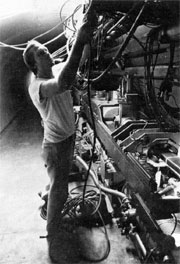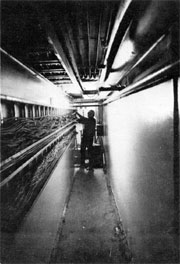E-F Sector Cooldown "Looks Good" for November
Hundreds of miles of cables have been installed and carefully checked for monitoring and controlling the myriad critical points of the system. One of the 8 refrigerator systems involved in the E and F sectors sends back as many data points as the entire 500-GeV conventional accelerator did. Ultimately there will be 24 such refrigeration systems. Only the expansion engines themselves, being given last minute adjustment in the Cross Gallery, remain to be installed by the target date.
To control all of this, the new VAX computer systems are being brought online. The VAX is more powerful and sophisticated than the Xerox XDS530 computers used for the accelerator control and monitoring until now. This increased power is bought at the price of a vastly more complicated programming effort. One of the major efforts in the start up of the two sectors is the programming readiness.
Finally, the November tests will involve the preliminary tests of the final power-supply configuration. Massive 2 in. x 2 in. copper bus salvaged from the Chicago Cyclotron magnet is used to bus the power supplies to the magnets. A major effort is installation of 4 complete power supply systems at E2, E3, F2, F3 service buildings. By the time the supermagnets are cold and superconducting, these systems will be ready to power the magnets. Meanwhile the injection system to transfer the proton beam from the Main Ring to the Energy Saver has been installed at E0 and successfully tested.
The Accelerator Division has been heavily supported by the Technical Division and the Research Division in all of these efforts. Once the two sector tests begin the system will be further strained as personnel struggle to master the very complicated operational systems at the same time installation work continues in B, C, D sectors to complete the entire Energy Saver complex.
It is an exciting period for the Laboratory as nearly eight years of sustained effort now moves swiftly to fruition, moving towards the goal of 1 TeV.





